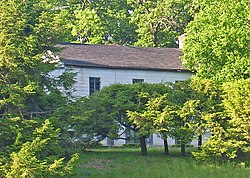History
Founding and early products
The foundry began operation in 1817. Its establishment had been encouraged by President James Madison, who, after the War of 1812, desired domestic foundries to produce artillery. [3] Cold Spring was an ideal site: there were many local iron mines, timber for charcoal to fuel a forge was abundant, and the nearby Margaret's Brook provided water power to drive machinery. The site was guarded by the Federal government's West Point Academy, across the Hudson River, and the river provided transport for finished products. [3]
The West Point Foundry Association was incorporated by Gouverneur Kemble, who was of a merchant family in New York City (his mother's family had associations in Putnam County), and the foundry followed in 1817. [3] Artillery was tested by shooting across the Hudson at the desolate slopes of Storm King Mountain (which would later have to be swept for unexploded ordnance as a result after some of it exploded during a 1999 fire). [4] The platform used for mounting artillery for proofing was uncovered during Superfund work in the early 1990s. [5] Besides artillery, the foundry also produced iron fittings for civilian uses, such as pipe for the New York City water system and shipment to sugar mills in the West Indies. A number of early locomotives were built at the foundry, including the Best Friend of Charleston (the first to be put into commercial service), the West Point (the third built for service in the United States), the DeWitt Clinton (the fourth, and first to operate in New York state), Phoenix, and Experiment. [3]
Parrott years and the Civil War
In 1835, Captain Robert Parker Parrott, an 1824-graduate of the United States Military Academy at West Point, was appointed as an inspector of ordnance at the foundry for the U.S. Army. The following year he resigned his commission and on October 31, 1836, was appointed superintendent of the foundry. It prospered over his long tenure, and was the site of numerous experiments with artillery and projectiles, culminating in his invention of the Parrott rifle cannon in 1860. [6] In 1843 the foundry also manufactured the USS Spencer, a revenue cutter which was the first iron ship built in the U.S.A. [3]
The foundry was busiest during the American Civil War due to military orders: at that time it had a workforce of 1,400 people and produced 2,000 cannon and three million shells. [3] Parrott also invented an incendiary shell which was used in an 8-inch Parrott rifle cannon (the "Swamp Angel") to bombard Charleston. The importance of the foundry for the war effort can be measured by the fact that President Abraham Lincoln visited and inspected it in June 1862. [7]
The fame of the foundry was such that Jules Verne, for his novel From the Earth to the Moon , chose it as the contractor for the Columbiad, a spaceship-launching cannon. [8]
Decline and demise
In 1867, Parrott resigned as superintendent, although he continued to experiment with artillery designs until his death in 1877. [9] Business of the foundry decreased due to competition from more modern techniques of iron and steel production. It had discontinued the use of charcoal and begun to purchase coal from Pennsylvania about 1870. However, it was unable to avoid receivership in 1884 and bankruptcy in 1889. [10] It was sold in 1897 to the Cornell brothers, makers of sugar mills, and ceased operation in 1911. [3]
This page is based on this
Wikipedia article Text is available under the
CC BY-SA 4.0 license; additional terms may apply.
Images, videos and audio are available under their respective licenses.





